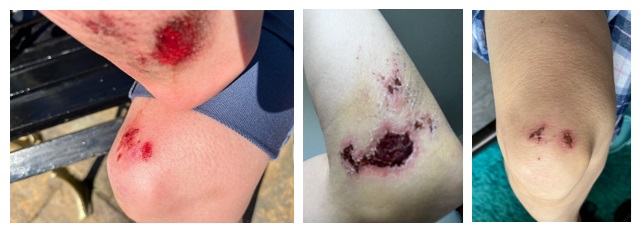Skin friction injuries - abrasions
When a superficial shearing force is applied across the surface of the skin (friction), it can exceed the mechanical resilience of the ability of the skin to withstand force and breach the bonds between the keratinised cells to cause a superficial wound or abrasion. The most superficial of these abrasions would be within the epidermis or just contacting the dermis. The “saw tooth” relationship between the dermis and the epidermis means that the adherence and surface area of contact between the two layers is large but also means that the plane of injury in a shearing force can damage both the epidermis and expose the dermis at the same time and at the same depth of injury. The pain receptors lie in the superficial dermis and produce pain signals when exposed to air.
In the case of very superficial injuries that just involve the tougher keratinised epidermis, these may not expose the free nerve endings that give pain but will instead activate pain via chemicals of the acute inflammatory response which will typically subside in two to three days. Hence these injuries are superficial and of lower risk for complications, and they heal quickly.
Skin injuries that are painful often present like burns with wide superficial injuries down to the dermis where the free nerve endings are. Common skin injuries in rugby are of mixed depth but mostly superficial, are around the size of a golf ball to a tennis ball and most commonly occur over the anterior knees or posterior elbows, although they occasionally can occur at other sites and at much larger or smaller sizes.
The normal process of healing
Over the first 24 hours, once any bleeding has stopped, the acute inflammatory process is activated, and the wound focusses its efforts on removing damaged tissues or contamination (debridement). The cells and secretions of the abrasions will begin to form a mature “scab” over the wound to maintain its internal environment to allow healing via fibroblast activation, contraction from the wound edges and epithelialisation beneath the scabs over around seven to ten days at which point the scabs will fall off to reveal a healed base.
The wound would not usually be significant enough to prevent the player from returning to training or competition, however, an early return means the mature scab often cracks (particularly over joints) or is traumatically and very painfully removed during activities to fall off leaving a painful non-epithelialised base that bleeds and exposes extremely sensitive pain receptors due to the surrounding inflammatory chemicals.
Risk of infection
Secondary infection can occur at this point, with new bacteria entering the wound that may overwhelm the immune response. With further injury, the whole healing process begins again with further scabbing. The cycle perpetuates into the next traumatic injury until inevitably an infection occurs, antibiotics are required and time loss from playing or training is sustained.
The journey for the player is one of initial pain, sleep disturbance and infection risk to further injury with further pain, bleeding and infection risk and eventual time loss.

Knee and elbow abrasions at day zero (left) and day six (middle and right) with no medical intervention. Note the initial serous wounds with visible dermis and subsequent scabbing which is both painful and brittle and restricting joint movement. Scabs will be injured again and risk secondary infection into the skin or bursa at the next training session.